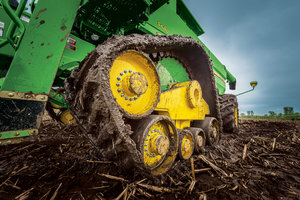As the fall harvest continues to push on across the Midwest, frequent storms and rainfall have dampened many producers’ fields, and this trend will likely continue through October.
Dr. H. Mark Hanna, an agricultural engineer with Iowa State University, has recently published a series of combine adjustment tips that could help producers better cope with these wet field conditions. Hanna explains that coarse grains (corn and soybeans) typically thresh fairly easily, but wet conditions may slow the field-drying process.
Corncobs or soybean pods that have been exposed to substantial amounts of rainfall may be difficult to thresh and greater rotor speed or reduced concave clearance may be required in these circumstances, Hanna suggests. However, he urges combine operators to not increase rotor speed or decrease concave clearance more than necessary.
When deciding whether or not combine adjustment is necessary, Hanna suggests checking for unthreshed soybeans or corn behind the machine and inside the grain tank. Aggressive threshing could cause damage to the seed coats, so producers should make sure it is needed before proceeding.
Hanna says, “In corn, the head should be operated low enough to gather all ears. Avoid going lower than necessary if a significant amount of soil or sediment is on lower parts of the stalk, as soil adds wear inside the combine and increases cleaning load. If ears hang low, the head will need to be operated low enough for gathering. Soybeans will have to be cut at ground level, regardless.”
With the wet weather expected to continue, these tips could prove to be valuable for producers in the Midwest.
